Abstract
An outbreak of parvovirus B19 infection at a primary school was investigated using saliva samples. Antibody capture immunoassays for salivary B19 IgG and IgM were developed using a recombinant B19 antigen and monoclonal antibody to B19 virus. Evaluation of the salivary IgG assay using paired serum and saliva samples from 43 staff at St Thomas' Hospital showed that it had a sensitivity of 100% and a specificity of 95%. Evaluation of the salivary B19 IgM assay using 87 paired blood and saliva samples from a study of general practitioner rubella notifications showed it had a sensitivity of 60% and a specificity of 98%. Using the salivary assay the level of B19 IgG within 2 weeks of the start of the outbreak ranged from 5-33% in children and 29% in staff. By detecting salivary B19 IgM and/or B19 IgG seroconversions, attack rates of 8-50% in children in different classes and 47% in staff were observed. Household transmission was also studied and an attack rate of 45% was recorded in 11 susceptibles. After the outbreak, the level of B19 IgG in children with the highest attack rates was 60-70%, similar to that seen in adults in the UK. This study highlights the risk of B19 infection in an institutional setting and shows that saliva samples are a useful alternative to blood.
Full text
PDF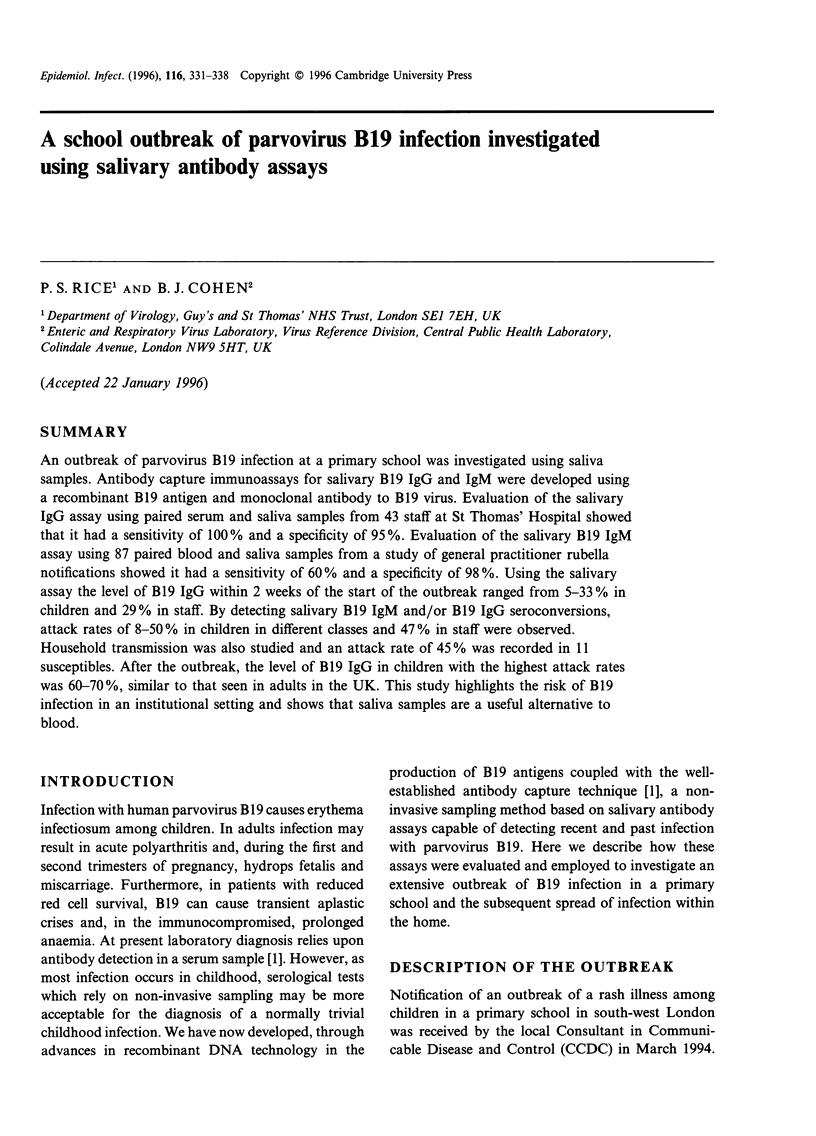
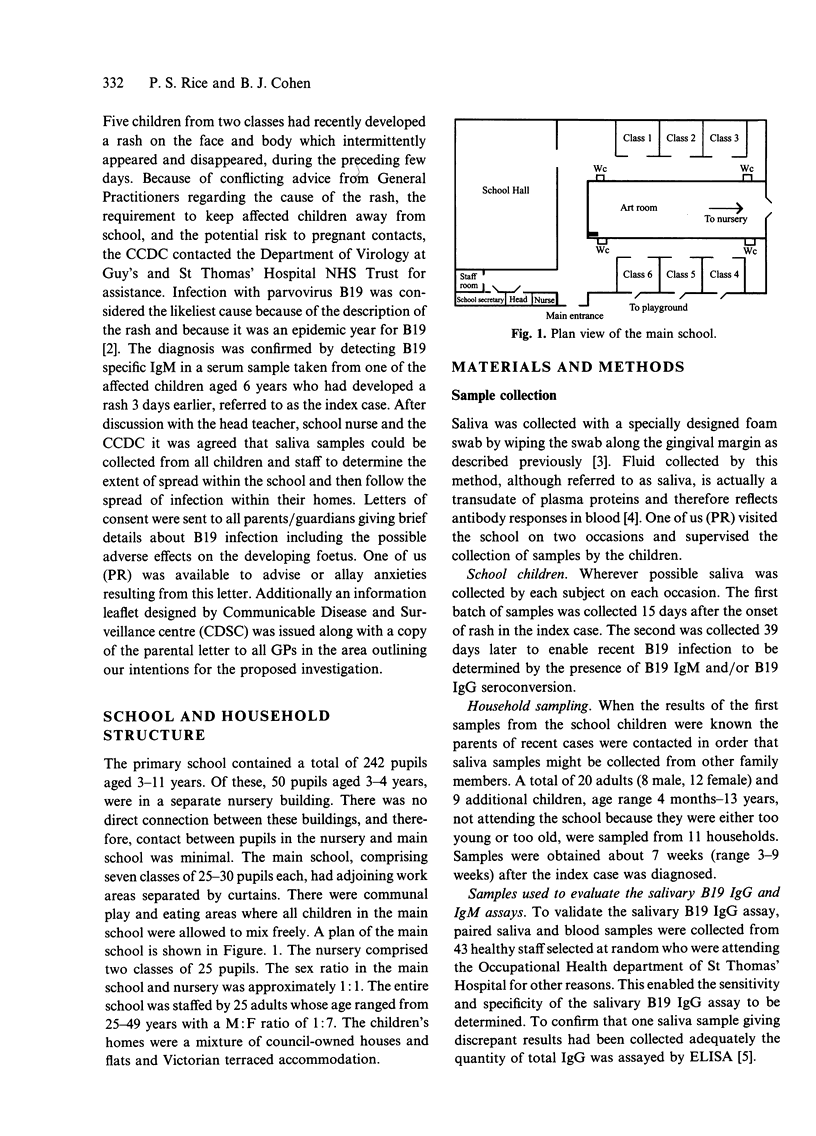
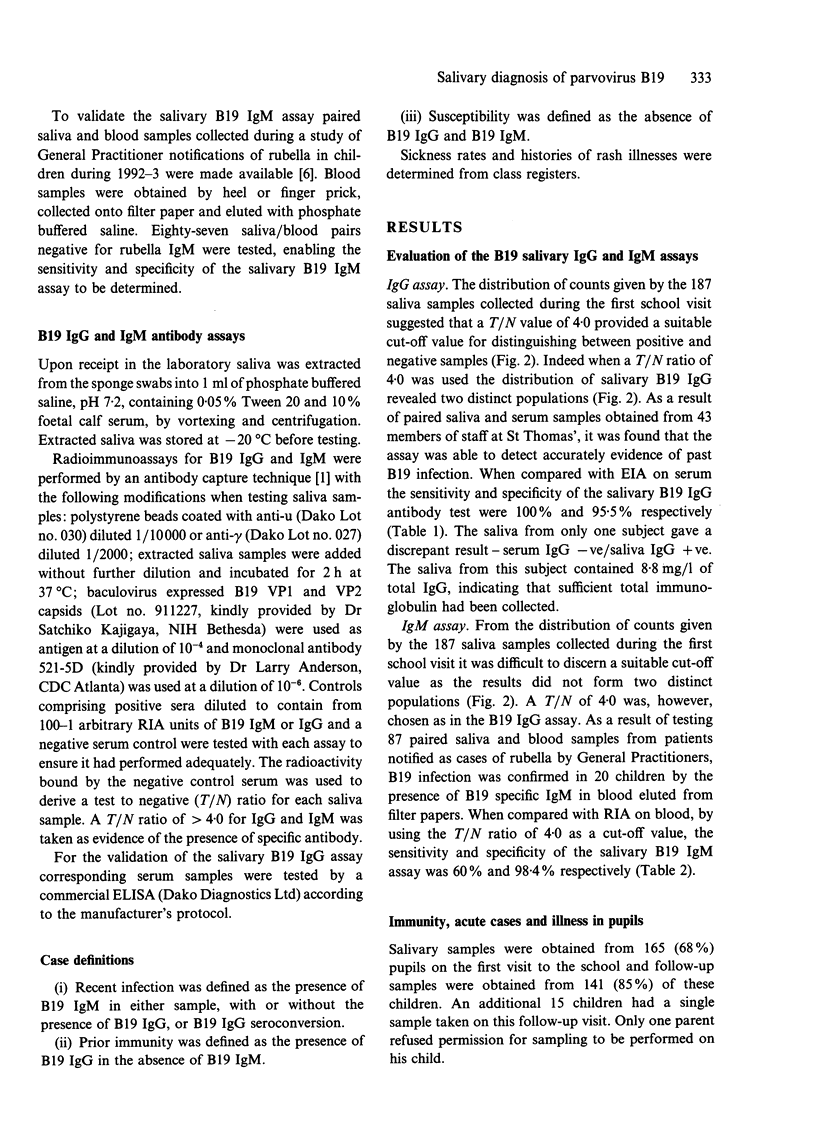
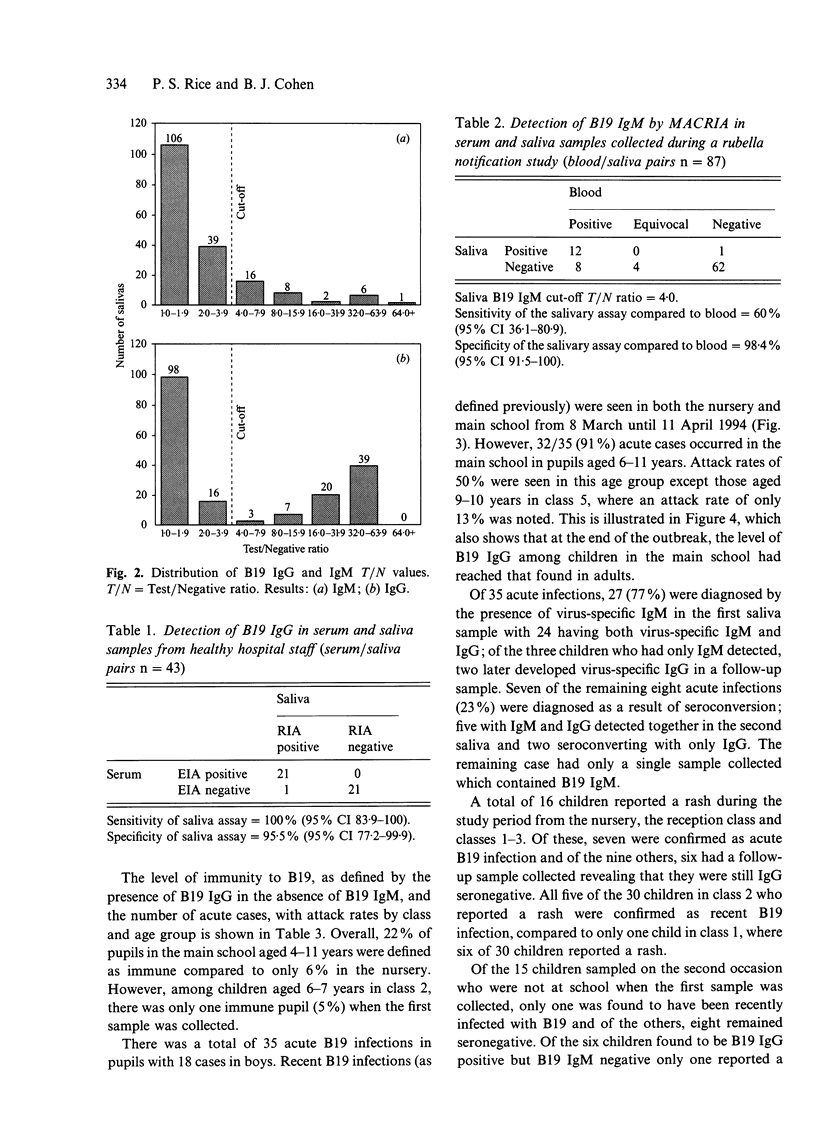
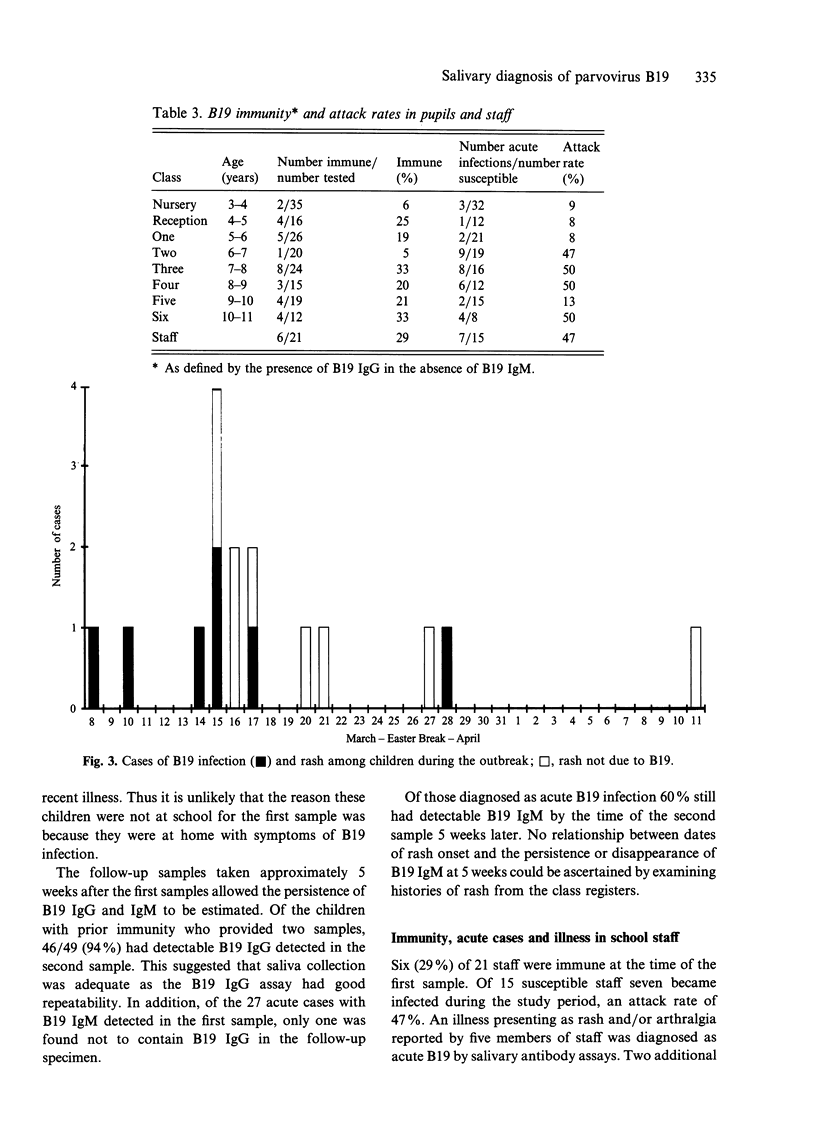
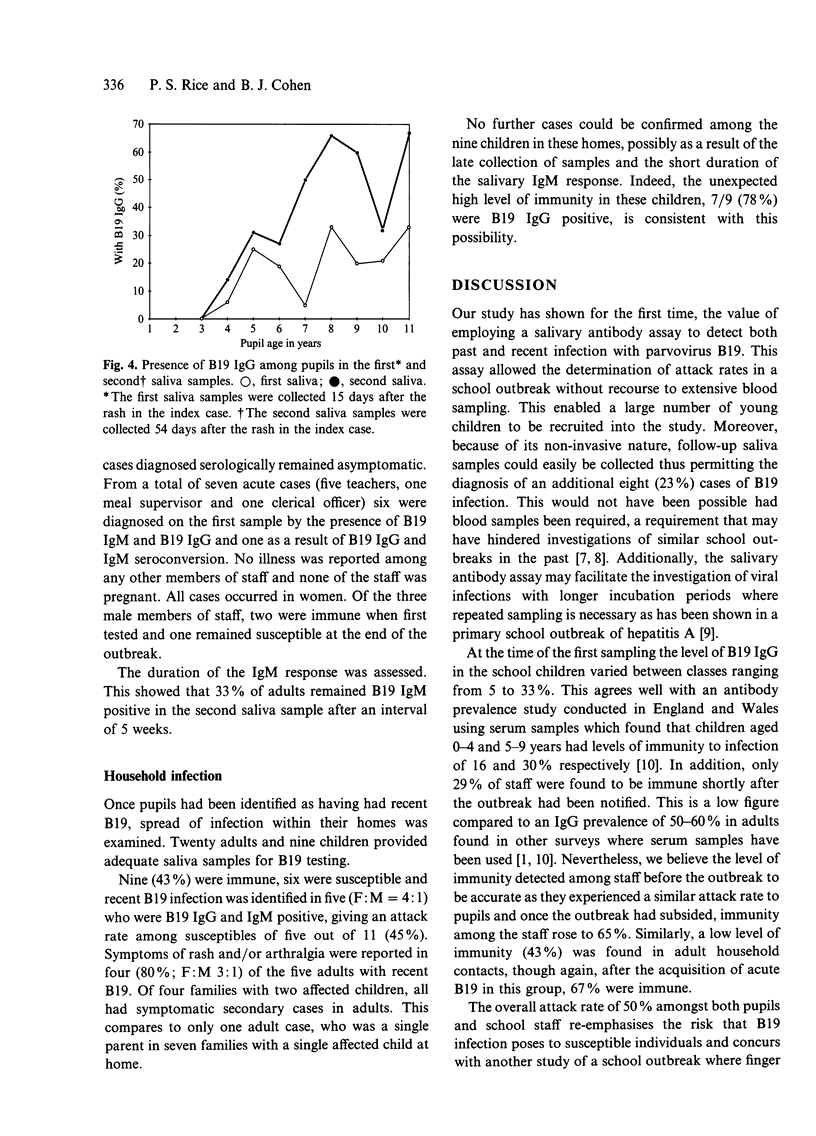
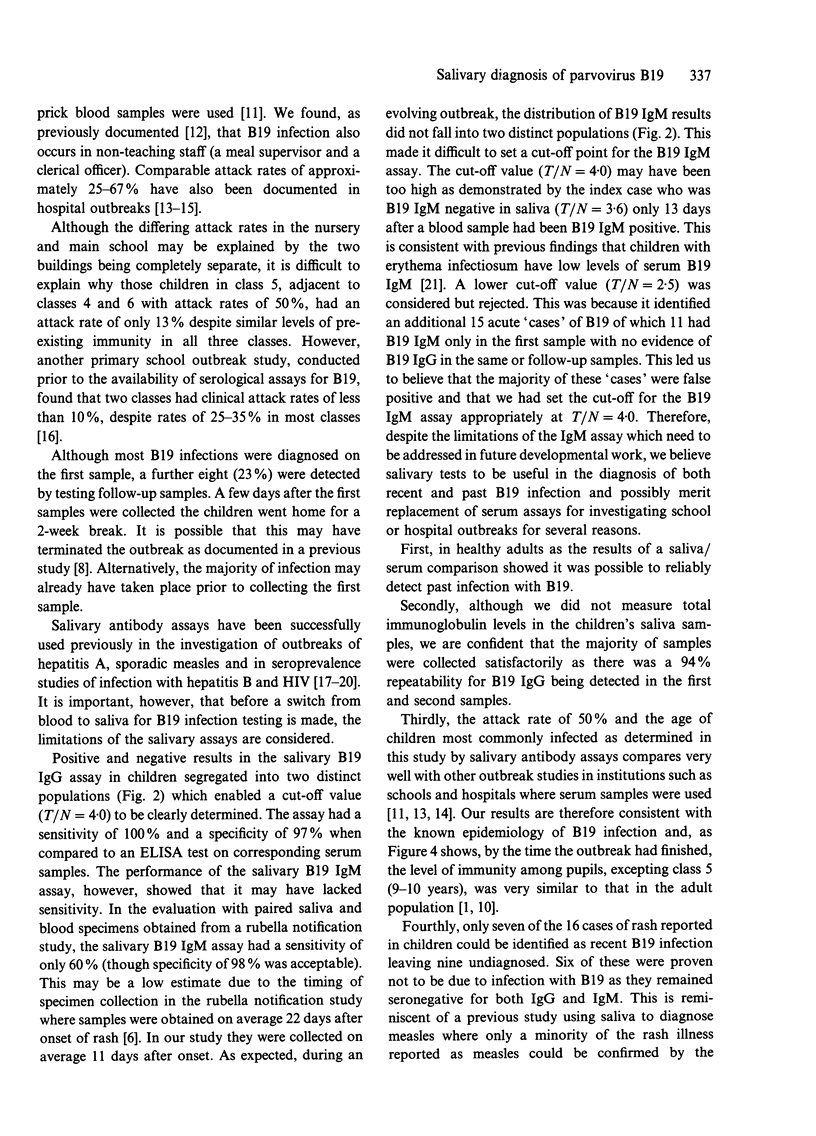
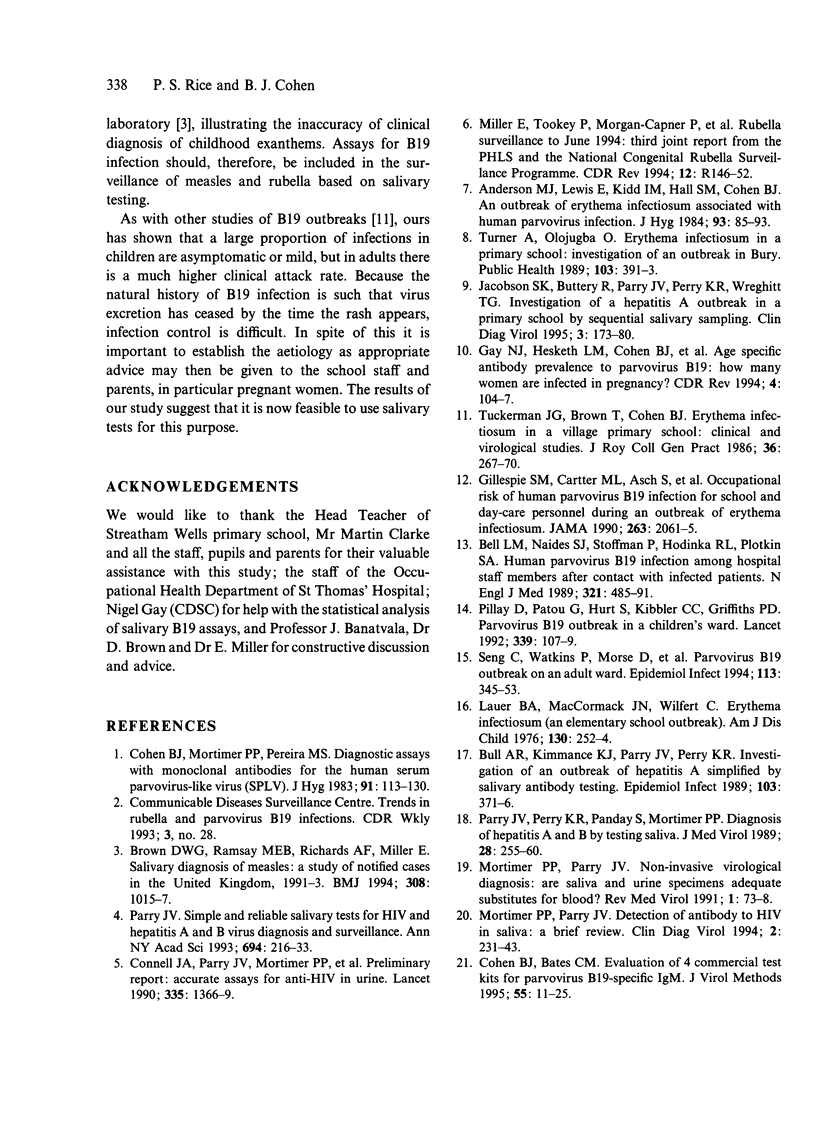
Selected References
These references are in PubMed. This may not be the complete list of references from this article.
- Anderson M. J., Lewis E., Kidd I. M., Hall S. M., Cohen B. J. An outbreak of erythema infectiosum associated with human parvovirus infection. J Hyg (Lond) 1984 Aug;93(1):85–93. doi: 10.1017/s0022172400060964. [DOI] [PMC free article] [PubMed] [Google Scholar]
- Bell L. M., Naides S. J., Stoffman P., Hodinka R. L., Plotkin S. A. Human parvovirus B19 infection among hospital staff members after contact with infected patients. N Engl J Med. 1989 Aug 24;321(8):485–491. doi: 10.1056/NEJM198908243210801. [DOI] [PubMed] [Google Scholar]
- Brown D. W., Ramsay M. E., Richards A. F., Miller E. Salivary diagnosis of measles: a study of notified cases in the United Kingdom, 1991-3. BMJ. 1994 Apr 16;308(6935):1015–1017. doi: 10.1136/bmj.308.6935.1015. [DOI] [PMC free article] [PubMed] [Google Scholar]
- Bull A. R., Kimmance K. J., Parry J. V., Perry K. R. Investigation of an outbreak of hepatitis A simplified by salivary antibody testing. Epidemiol Infect. 1989 Oct;103(2):371–376. doi: 10.1017/s0950268800030715. [DOI] [PMC free article] [PubMed] [Google Scholar]
- Cohen B. J., Bates C. M. Evaluation of 4 commercial test kits for parvovirus B19-specific IgM. J Virol Methods. 1995 Sep;55(1):11–25. doi: 10.1016/0166-0934(95)00040-2. [DOI] [PubMed] [Google Scholar]
- Cohen B. J., Mortimer P. P., Pereira M. S. Diagnostic assays with monoclonal antibodies for the human serum parvovirus-like virus (SPLV). J Hyg (Lond) 1983 Aug;91(1):113–130. doi: 10.1017/s0022172400060095. [DOI] [PMC free article] [PubMed] [Google Scholar]
- Connell J. A., Parry J. V., Mortimer P. P., Duncan R. J., McLean K. A., Johnson A. M., Hambling M. H., Barbara J., Farrington C. P. Preliminary report: accurate assays for anti-HIV in urine. Lancet. 1990 Jun 9;335(8702):1366–1369. doi: 10.1016/0140-6736(90)91245-6. [DOI] [PubMed] [Google Scholar]
- Gillespie S. M., Cartter M. L., Asch S., Rokos J. B., Gary G. W., Tsou C. J., Hall D. B., Anderson L. J., Hurwitz E. S. Occupational risk of human parvovirus B19 infection for school and day-care personnel during an outbreak of erythema infectiosum. JAMA. 1990 Apr 18;263(15):2061–2065. [PubMed] [Google Scholar]
- Jacobson S. K., Buttery R., Parry J. V., Perry K. R., Wreghitt T. G. Investigation of a hepatitis A outbreak in a primary school by sequential saliva sampling. Clin Diagn Virol. 1995 Feb;3(2):173–180. doi: 10.1016/0928-0197(94)00033-q. [DOI] [PubMed] [Google Scholar]
- Lauer B. A., MacCormack J. N., Wilfert C. Erythema infectiosum. An elementary school outbreak. Am J Dis Child. 1976 Mar;130(3):252–254. doi: 10.1001/archpedi.1976.02120040030006. [DOI] [PubMed] [Google Scholar]
- Miller E., Tookey P., Morgan-Capner P., Hesketh L., Brown D., Waight P., Vurdien J., Jones G., Peckham C. Rubella surveillance to June 1994: third joint report from the PHLS and the National Congenital Rubella Surveillance Programme. Commun Dis Rep CDR Rev. 1994 Nov 11;4(12):R146–R152. [PubMed] [Google Scholar]
- Mortimer P. P., Parry J. V. Detection of antibody to HIV in saliva: a brief review. Clin Diagn Virol. 1994 Aug;2(4-5):231–243. doi: 10.1016/0928-0197(94)90048-5. [DOI] [PubMed] [Google Scholar]
- Parry J. V., Perry K. R., Panday S., Mortimer P. P. Diagnosis of hepatitis A and B by testing saliva. J Med Virol. 1989 Aug;28(4):255–260. doi: 10.1002/jmv.1890280410. [DOI] [PubMed] [Google Scholar]
- Parry J. V. Simple and reliable salivary tests for HIV and hepatitis A and B virus diagnosis and surveillance. Ann N Y Acad Sci. 1993 Sep 20;694:216–233. doi: 10.1111/j.1749-6632.1993.tb18355.x. [DOI] [PubMed] [Google Scholar]
- Pillay D., Patou G., Hurt S., Kibbler C. C., Griffiths P. D. Parvovirus B19 outbreak in a children's ward. Lancet. 1992 Jan 11;339(8785):107–109. doi: 10.1016/0140-6736(92)91009-w. [DOI] [PubMed] [Google Scholar]
- Seng C., Watkins P., Morse D., Barrett S. P., Zambon M., Andrews N., Atkins M., Hall S., Lau Y. K., Cohen B. J. Parvovirus B19 outbreak on an adult ward. Epidemiol Infect. 1994 Oct;113(2):345–353. doi: 10.1017/s0950268800051773. [DOI] [PMC free article] [PubMed] [Google Scholar]
- Tuckerman J. G., Brown T., Cohen B. J. Erythema infectiosum in a village primary school: clinical and virological studies. J R Coll Gen Pract. 1986 Jun;36(287):267–270. [PMC free article] [PubMed] [Google Scholar]
- Turner A., Olojugba O. Erythema infectiosum in a primary school: investigation of an outbreak in Bury. Public Health. 1989 Sep;103(5):391–393. doi: 10.1016/s0033-3506(89)80010-1. [DOI] [PubMed] [Google Scholar]


